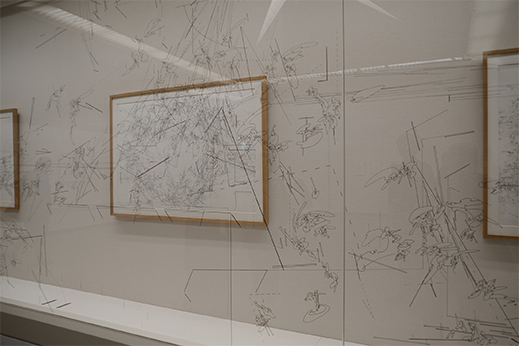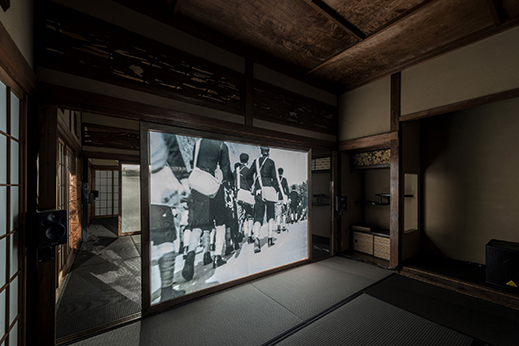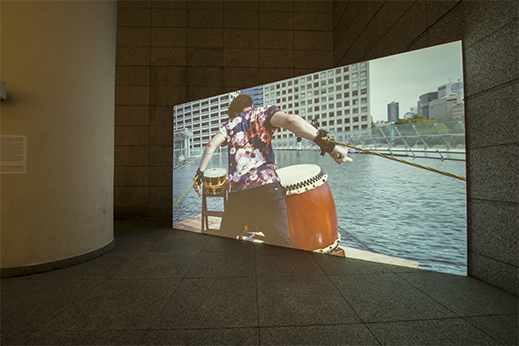 |
Focus features two in-depth reviews each month of fine art, architecture and design exhibitions and events at art museums, galleries and alternative spaces around Japan. The contributors are non-Japanese residents of Japan. |
|
|
 |
 |
 |
After the Deluge: The Show Goes On at Aichi Triennale 2019
Colin Smith |
 |
Ugo Rondinone, vocabulary of solitude (2016), installation view at Aichi Triennale 2019. Visitors are welcome to lounge among the clowns. Photo by Tetsuo Ito |
In Japan, even those who don't follow art have heard about Aichi Triennale 2019 because of controversy that erupted over one section (one work, really) right after it opened on 1 August. While publicity is always good, there is far more to this international contemporary art festival than the section (currently closed) that sparked the media frenzy. In this writer's opinion, this fourth Aichi Triennale is the best so far (and only open for two more weeks -- do not delay!), and while a member of the organizing committee says the stir has had little net impact on the number of visitors, one hopes the wide recognition the festival inadvertently gained will help it grow and prosper in the future.
James Bridle, Drone Shadow (2019), installation view at Aichi Triennale 2019. Easy to miss on the ground, so look for an upper-floor window to get a bird's-eye view. Photo by Tetsuo Ito |
We'll return to the controversy later, but as to what's now on view: At the main venue, the Aichi Arts Center, highlights include Ugo Rondinone's vocabulary of solitude (2016), a large room full of life-sized clowns whose gaudy costumes amusingly contrast with poses and expressions of fatigue and ennui. A number of works employ or address new technologies, including Heather Dewey-Hagborg's Stranger Visions (2012-13), a series of 3D-printed portraits of strangers based on DNA samples collected from street detritus, as well as several video installations like Gabin Ito's immersive, satirical Modern Fart: Inaugural Issue (2019) and Yuan Goang-Ming's eerie drone-shot Everyday Maneuver (2018), showing downtown Taipei completely deserted during an air-raid drill. Speaking of drones, James Bridle's Drone Shadow (2019), a life-sized silhouette of an RQ-4 Global Hawk, takes a little finding -- it's on the ground outside the Arts Center, but look out a window from one of the top floors. There is also engaging abstract work by Yukari Bunya, Yohei Imamura, and Amanda Martinez. This last consists of enigmatic, monochromatic resin-cast pieces with repeated, textured patterns, which a staff member at Art Playground TALK -- a zone where visitors can chat freely with staff about the art, one of the festival's five Art Playgrounds -- says are often asked about.
 |
|
Yukari Bunya, looking at the vacant scenery (2017-2019), installation view at Aichi Triennale 2019. Bunya's compelling drawings capture the intangible in pure line. Photo by Tetsuo Ito |
Arrive early, and there's time to see everything in Nagoya in a day. Head from the Aichi Arts Center to the nearby Nagoya City Art Museum, then make the rounds of Shikemichi and Endoji, neighborhoods with the city's oldest shopping arcade and many historic buildings (rare in Nagoya), where art installations in spaces like the Ito Residence and the Nagono 1-Chome and 2-Chome Tenement Houses are open into the evening. It's a particularly successful endeavor to bring art out of the conventional "white cube" and into a community and present it in unique architectural spaces.
Tadasu Takamine, Anti-thesis: Gazing up at the endless blue // stained forever by its color // I have ceased to be myself (2019), installation view at Aichi Triennale 2019. A defunct high-school pool undergoes a metamorphosis in this site-specific work. Photo by Takeshi Hirabayashi |
To get to sites in Toyota City as well as in Nagoya might require staying overnight. In Toyota you'll find site-specific works in intriguing locations, including Tadasu Takamine's elegant transformation of part of an old swimming pool at the Former Toyota Higashi High School into a weathered Minimalist sculpture, and Ho Tzu Nyen's six-channel video installation on kamikaze pilots at Kirakutei, an inn and restaurant where they used to enjoy a last supper before missions.
 |
|
Ho Tzu Nyen, Hotel Aporia (2019), installation view at Aichi Triennale 2019. One of several explorations of wartime history that are still on view. Photo by Takeshi Hirabayashi |
To return to the controversy: Aichi Triennale 2019 initially included the one-room mini-exhibition After "Freedom of Expression?", which replicated and expanded a 2015 show at Tokyo's Gallery Furuto of works that had been censored or removed from view in Japan, with accompanying explanations. Among them was Statue of Peace (2011) by Kim Seo-kyung and Kim Eun-sung, a sculpture of a seated young girl representing World War II-era "comfort women." The Nagoya mayor and other politicians objected, and things got ugly fast, with a constant stream of protests and violent threats causing the section to close after only three days for safety reasons.
Twelve other artists or groups either pulled or modified their works in solidarity, and posted a joint statement "insist[ing] that 'After "Freedom of Expression?"' should be opened and remain on view until the scheduled closing of the exhibition." While the artists' desire to act is admirable, one could say this has the unfortunate effect of putting yet more art out of the view of visitors who are largely sympathetic, without making oppressors bat an eyelash. The irony of this outcome of an attempt to explore freedom of expression, at an art festival with the theme of "Taming Y/Our Passion," is obvious and tragic. Both the theme and the "Freedom of Expression?" restaging reflect Artistic Director Daisuke Tsuda's concern, clearly justified, with increasing polarization and intolerance exacerbated by the constant connectedness of our information society.
 |
|
Tsubasa Kato, 2679 (2019), installation view at Aichi Triennale 2019. Musicians play under duress: in another video, similarly bound rockers tackle "The Star-Spangled Banner." Photo by Takeshi Hirabayashi |
Actually, a number of other participating artists could have caused backlashes for similar reasons, but there has been nary a peep about them. Some of the most affecting works in the festival besides Ho Tzu Nyen's kamikaze piece are Tsubasa Kato's hilarious, poignant videos at the Aichi Arts Center of musicians attempting to perform while bound to one another and surrounding objects, highlighted by a tormented rendition of the Japanese national anthem "Kimigayo"; Hikaru Fujii's video installation at the Nagoya City Art Museum featuring archival footage of "Japanization" exercises in wartime Taiwan; and Bontaro Dokuyama's funny and heart-wrenching video in Shikemichi/Endoji, which deals with the same theme, showing elderly Taiwanese who grew up under Japanese rule and remain fluent in the language sharing memories and singing songs.
|
 |
|
|
|
Leung Chi Wo + Sara Wong, Endoji Meeting Room (2019), installation view at Aichi Triennale 2019. On the tables are vintage snapshots of locals, on the walls reenactments with a single figure isolated from group photos. Photo by Takeshi Hirabayashi
|
It has been four years since the first "Freedom of Expression?" show was held and three years since the last Triennale. Chief Curator Shihoko Iida remarks, "An event held every few years is a chance to gauge how things have changed since last time. What I took away from this incident was a sense of loss." On a more positive note, Iida says of what distinguishes the Aichi Triennale among art festivals: "We're committed to showing as many new and specially commissioned works as possible, within our capacity [43 of the 66 participants presented new works]. And while we have a theme, our goal is not simply to bring together works that 'illustrate' the theme. Rather than telling you 'A = A,' these works suggest that 'A = A+B,' or ask 'A = ?'"
This edition of the Aichi Triennale was a daring one considering its use of public museums and corporate sponsorship, which often cause organizers to shy from anything controversial. While major exhibitions in similar positions may be prone to self-censorship (or plain old censorship), there are a growing number of alternative and independent spaces without these constraints. In Nagoya, temporary artist-run space Sanatorium (2-10-10 Nagono, Nishi-ku) was launched as a response to the Afterc controversy by participating artists Kato and Dokuyama, and Dokuyama has opened another temporary space, TAGA-GU (2-8 Nagono, Nishi-ku) at a shrine in the Shikemichi/Endoji district in response to the issue. The aborted endeavor to provoke thought and action on freedom of expression was not in vain.
All images are courtesy of Aichi Triennale 2019. |
 |
 |
Colin Smith
Colin Smith is a translator and writer and a long-term resident of Osaka. His published writing includes the travel guide Getting Around Kyoto and Nara (Tuttle, 2015), and his translations, primarily on Japanese art, have appeared in From Postwar to Postmodern: Art in Japan 1945-1989: Primary Documents (MoMA Primary Documents, 2012) and many museum and gallery publications in Japan. |
|
 |
|